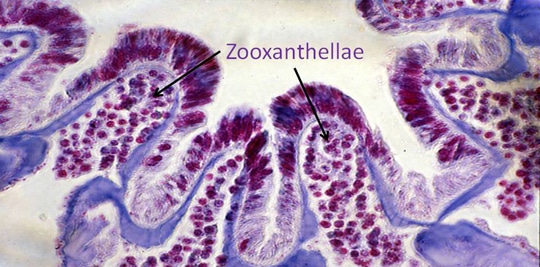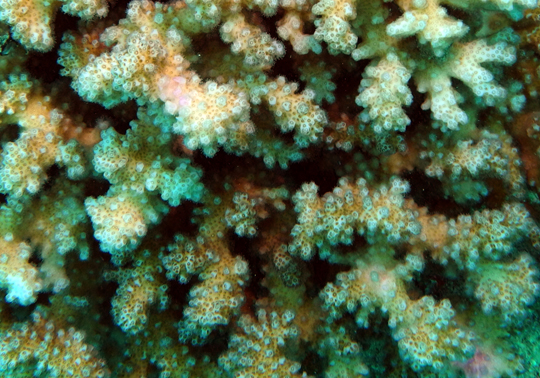Coral reefs are often called the rainforests of the seas. Teeming with life, reefs harbor a broad range of organisms that rely on a complex network of ecological interactions and symbiosis (close and often long-term interaction between two or more different biological species).
The diversity and complexity of coral reefs starts at the microscopic level. Within the coral tissue, symbiotic algae (dinoflagellates), commonly called zooxanthellae (their scientific name is Symbiodinium), are crucial to the coral hosts. Like leaves from a tree, these microscopic algae harvest light and produce energy in the form of carbon rich compounds.

These symbiotic algae remove and use the coral’s waste products (CO2, nitrogen) for growth and photosynthesis. In return the coral gains energy rich organic carbon, created by the algae through photosynthesis. This symbiotic relationship provides most of the coral’s energy needs and contributes to the production of the coral limestone skeleton.
The loss of these symbiotic algae, a process known as coral bleaching, reveals the coral’s white limestone skeleton as the tissue looses all pigmentation. On its own, the coral animal struggles to meet its’ energy requirements, and, if prolonged, this is usually lethal for the coral.

The disruption of this obligate symbiosis can be triggered by a number of stress factors, including rapid and extreme temperature changes, high light levels and pollution. The susceptibility to these factors can vary according to the coral and type of symbiotic algae, or zooxanthellae, that they host.
Corals can harbor one or more types of zooxanthellae. The type of symbionts also varies with environmental conditions and geographic region. One of the many goals of our mission, here in French Polynesia, is to assess the diversity of symbiont types associating with the coral genus Pocillopora, a widely distributed branching coral found throughout the Pacific and Indian Oceans. So far, the scientific team has found and sampled several Pocillopora species that are abundant on the fore reef, but appear to be uncommon and rare on the inner lagoonal reefs. These samples will be taken to the laboratory to assess which symbionts they host. This information about symbiotic algae can help scientists and managers foresee some of the areas that will be more susceptible or more resilient to stress factors, such as increasing temperature.

With over 250 samples collected thus far, the science team will continue their work to collect samples of symbiotic algae from multiple sites and over different environmental conditions. Also, we have been working on an overall assessments of the photosynthetic efficiency and photosystems “health” condition, using a special fluorometer that the foundation has recently acquired. Find out more on tomorrow’s post.
(Photos by: Dr. Andy Bruckner)
To follow along and see more photos, please visit us on Facebook! You can also follow the expedition on our Global Reef Expedition page, where there is more information about our research and team members.